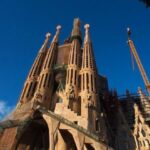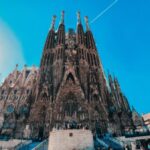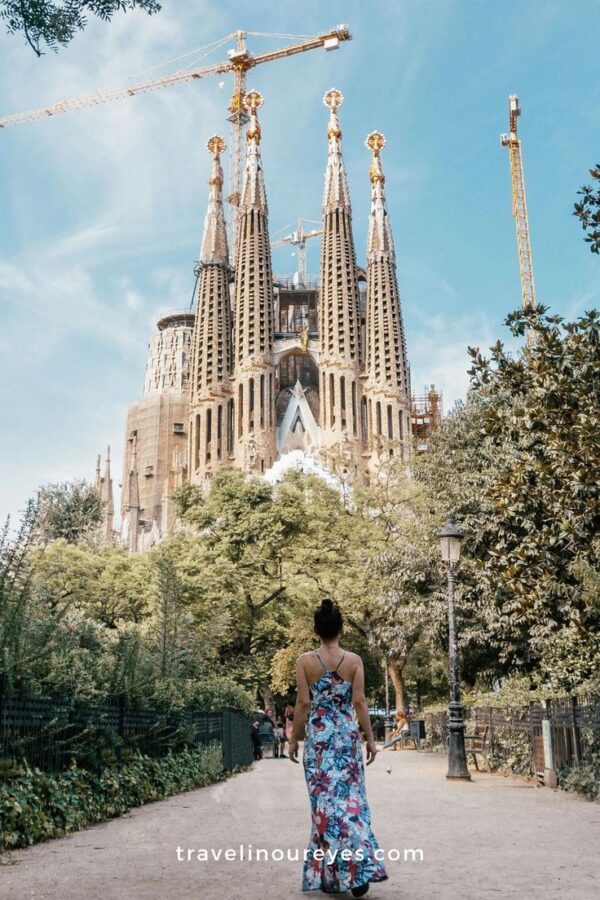
Barcelona's Sagrada Familia stands as a testament to architectural innovation, blending Gothic and Art Nouveau styles in a way that captivates visitors from around the world. This iconic basilica, designed by the visionary Antoni Gaudí, offers a glimpse into the intricate details and spiritual significance that define its structure.
In this exploration of the landmark, we embark on Unveiling the Wonders Inside Barcelona's Sagrada Familia: A Journey Through Architectural Marvels. Each corner reveals a story, from its stunning facades to the mesmerizing play of light within, showcasing the genius of Gaudí and his dedication to creating a masterpiece that transcends time.
Exploring the Architectural Genius of Antoni Gaudí at Sagrada Familia
Antoni Gaudí's architectural genius is vividly displayed in the Sagrada Familia, where each element reflects his unique vision. The basilica is renowned for its organic shapes and intricate details, harmonizing with nature. Gaudí employed innovative techniques, such as the use of hyperbolic paraboloids and catenary arches, which not only enhance the aesthetic appeal but also provide structural integrity.
A key aspect of Gaudí's work at Sagrada Familia is his profound understanding of light and color. The stained glass windows, designed to flood the interior with a kaleidoscope of colors, play a pivotal role in creating an otherworldly atmosphere. This interplay of light is carefully calculated, as reflected in the following elements:
- Color Gradation: The windows transition from cooler tones at the base to warm hues at the top.
- Natural Illumination: Gaudí designed the spaces to maximize the effects of sunlight throughout the day.
- Symbolism: Each color choice carries spiritual meanings, enhancing the basilica's sacred ambiance.
Gaudí's integration of nature into his design is another hallmark of his genius. The Sagrada Familia is adorned with motifs inspired by flora and fauna, creating a sense of harmony between architecture and the environment. Notably, the facades illustrate biblical stories through sculptural elements that resemble natural formations, making the building a living testament to Gaudí's reverence for nature.
Finally, the ongoing construction of the Sagrada Familia, projected for completion in the coming years, symbolizes Gaudí's enduring legacy. The collaboration of modern technology with traditional craftsmanship continues to elevate the basilica's architectural significance. This fusion not only preserves Gaudí's original vision but also transforms Sagrada Familia into a dynamic work of art that evolves with time.
The Symbolism Behind the Colors of Sagrada Familia's Stained Glass
The stained glass windows of Sagrada Familia are more than mere decorative elements; they are imbued with deep symbolism that reflects the spiritual narrative of the basilica. Each color is meticulously selected to convey specific themes and emotions, contributing to the overall sacred experience. For instance, blues and greens often symbolize serenity and tranquility, while reds and oranges evoke feelings of warmth and passion.
Color transitions throughout the basilica illustrate a journey from earthly life to divine existence. At the base, cooler colors represent the natural world, gradually shifting to warmer hues that suggest the celestial. This deliberate gradation serves to guide the visitor’s emotional response, enhancing the meditative atmosphere within. The use of light is equally significant, with sunlight filtering through the windows, creating a dynamic interplay of color that changes throughout the day.
Moreover, the stained glass serves a dual purpose: it not only beautifies the interior but also educates visitors about biblical stories and teachings. The vibrant colors and intricate designs depict scenes from the life of Christ and the Virgin Mary, making the windows a visual catechism. This fusion of art and spirituality reflects Gaudí’s dedication to creating a space that resonates with both the heart and the mind.
In summary, the colors of Sagrada Familia’s stained glass are a profound reflection of Gaudí’s vision, intertwining artistry with spirituality. Their symbolism not only enriches the aesthetic experience but also deepens the visitor's connection to the divine narrative that the basilica embodies. Through this brilliant use of color, Gaudí invites all who enter to embark on a transformative journey of faith and reflection.
A Closer Look at the Unique Facades of Barcelona's Sagrada Familia
The Sagrada Familia's facades are a testament to Antoni Gaudí's profound creativity and vision, each narrating a distinct chapter of the basilica's spiritual journey. The three main facades—Nativity, Passion, and Glory—are designed to reflect different aspects of Christ's life, showcasing Gaudí's ability to intertwine architecture with religious storytelling. This unique approach transforms the building into a narrative that unfolds as visitors move around its exterior.
Each facade features intricate sculptures and details that invite deeper contemplation. For instance, the Nativity Facade celebrates the birth of Christ through vibrant imagery, while the Passion Facade represents the suffering and sacrifice of Jesus. To better understand their significance, consider the following elements:
- Nativity Facade: Rich in organic forms and joyous themes, symbolizing hope and rebirth.
- Passion Facade: Characterized by stark, angular shapes, reflecting the solemnity of Christ's crucifixion.
- Glory Facade: Still under construction, it aims to depict the ascension and eternal glory of Christ, embodying the culmination of Gaudí's vision.
Moreover, the facades are adorned with natural motifs that echo Gaudí’s admiration for nature. They serve not only as artistic expressions but also as structural elements that enhance the building's stability. The use of light and shadow plays a crucial role in highlighting the details of these facades, creating a dynamic visual experience throughout the day.
In summary, the unique facades of the Sagrada Familia represent more than just architectural features; they encapsulate the spiritual essence of the basilica. Each facade invites visitors to engage with its narratives, enhancing their understanding of the larger themes of faith, sacrifice, and redemption that Gaudí sought to convey through his monumental work.
The Importance of Nature in Sagrada Familia's Design and Architecture
The Sagrada Familia's design intricately weaves the essence of nature into its architectural framework, reflecting Gaudí's belief that the natural world serves as the ultimate source of inspiration. By incorporating elements such as organic forms and botanical motifs, he creates a seamless connection between the basilica and its surrounding environment. This profound integration not only enhances the aesthetic appeal but also emphasizes the spiritual significance of nature within the sacred space.
Gaudí's approach to architecture is exemplified in the use of natural light, which plays a vital role throughout the basilica. The strategically placed windows are designed to mimic the way light filters through a forest canopy, bathing the interior in a soft, ethereal glow. This interaction between light and structure evokes a sense of tranquility and reverence, inviting visitors to reflect on the divine while immersed in the beauty of their surroundings.
Furthermore, the Sagrada Familia's facades are adorned with sculptural details that draw from the plant and animal kingdoms. These embellishments serve as a reminder of the interconnectedness of all creation, showcasing Gaudí's deep respect for the environment. Each facade tells a story, using natural symbolism to convey themes of growth, resurrection, and the eternal cycle of life.
In essence, the importance of nature in the Sagrada Familia's design transcends mere aesthetic choices; it encapsulates a philosophy that celebrates the divine within the natural world. Through this harmonious blend of architecture and ecology, Gaudí invites all who enter to experience a profound connection to both the spiritual and the earthly realms, fulfilling his vision of a living temple that honors creation itself.
Unraveling the Mysteries of Sagrada Familia's Fascinating Sculptures
The Sagrada Familia is not only an architectural masterpiece but also a canvas of intricate sculptures that narrate the life and teachings of Christ. Each sculpture serves as a visual sermon, crafted with a level of detail that invites contemplation. Gaudí’s unique approach allows these figures to blend seamlessly with the structure, transforming the basilica into a living storybook where visitors can explore the profound messages embedded within the artistry.
One of the most fascinating aspects of Sagrada Familia's sculptures is their symbolic significance. The figures are designed to convey spiritual themes through their expressions and postures. For instance, the Nativity facade features joyous scenes that celebrate the birth of Jesus, while the Passion facade presents a stark depiction of suffering. This deliberate contrast emphasizes the duality of the Christian experience, reflecting the highs and lows of faith.
In addition to their spiritual narratives, the sculptures also embody Gaudí's love for nature. Many figures incorporate natural motifs, such as flowers and trees, enhancing their connection to the divine creation. These organic forms not only beautify the structure but also serve as reminders of life, growth, and renewal, seamlessly integrating the essence of nature into the spiritual message of the Sagrada Familia.
Furthermore, the craftsmanship involved in creating these sculptures is a testament to the dedication of the artists and artisans working on the basilica. Employing both traditional techniques and modern innovations, they ensure that Gaudí's vision is meticulously executed. This ongoing collaboration between past and present highlights the enduring relevance of Sagrada Familia's message, captivating the hearts of all who visit.
Understanding the Historical Context of Sagrada Familia's Construction
The construction of the Sagrada Familia began in 1882, steeped in a complex historical context that shaped its design and progress. Initially conceived as a traditional Gothic church, the vision evolved dramatically with the involvement of Antoni Gaudí in 1883. His innovative approach, influenced by the Catalan Modernisme movement, sought to merge architecture with nature, intertwining the basilica's purpose with a profound spiritual narrative.
Throughout the years, the Sagrada Familia has witnessed numerous challenges, including financial constraints and the impact of historical events like the Spanish Civil War. These challenges have led to various periods of halted construction and shifting priorities. The original plans developed by Gaudí were often modified, yet many of his innovative ideas remained integral to the project, reflecting his unique architectural philosophy. Key historical milestones include:
- 1882: Groundbreaking of the Sagrada Familia.
- 1914: Death of Antoni Gaudí, leaving the project unfinished.
- 1936: Destruction of many original plans during the Spanish Civil War.
- 2026: Projected completion date, marking the centenary of Gaudí’s death.
As construction progressed into the 21st century, advancements in technology began to play a significant role in the project. Modern techniques, such as computer-aided design, have enabled architects to interpret and implement Gaudí's intricate designs more faithfully than ever before. This fusion of tradition and innovation not only pays homage to Gaudí's vision but also illustrates how architectural practices have evolved over time, ensuring that the Sagrada Familia continues to be a symbol of faith and artistic expression.
In essence, the historical context of the Sagrada Familia's construction reflects a journey marked by resilience and creativity. Each phase of its development embodies a dialogue between past and present, intertwining the legacy of Gaudí with contemporary aspirations. The basilica stands as a testament to both the enduring power of vision and the collaborative spirit required to bring such a monumental work to life.
 The Majestic Beauty of Sagrada Familia: Explore Barcelona's Official Website
The Majestic Beauty of Sagrada Familia: Explore Barcelona's Official Website The Complete Guide: Sagrada Familia in Barcelona - Finished Date, History and Must-See Attractions
The Complete Guide: Sagrada Familia in Barcelona - Finished Date, History and Must-See AttractionsIf you want to know other articles similar to Unveiling the Wonders Inside Barcelona's Sagrada Familia: A Journey Through Architectural Marvels you can visit the category WHERE YOU CAN GO.
Leave a Reply










Read more!